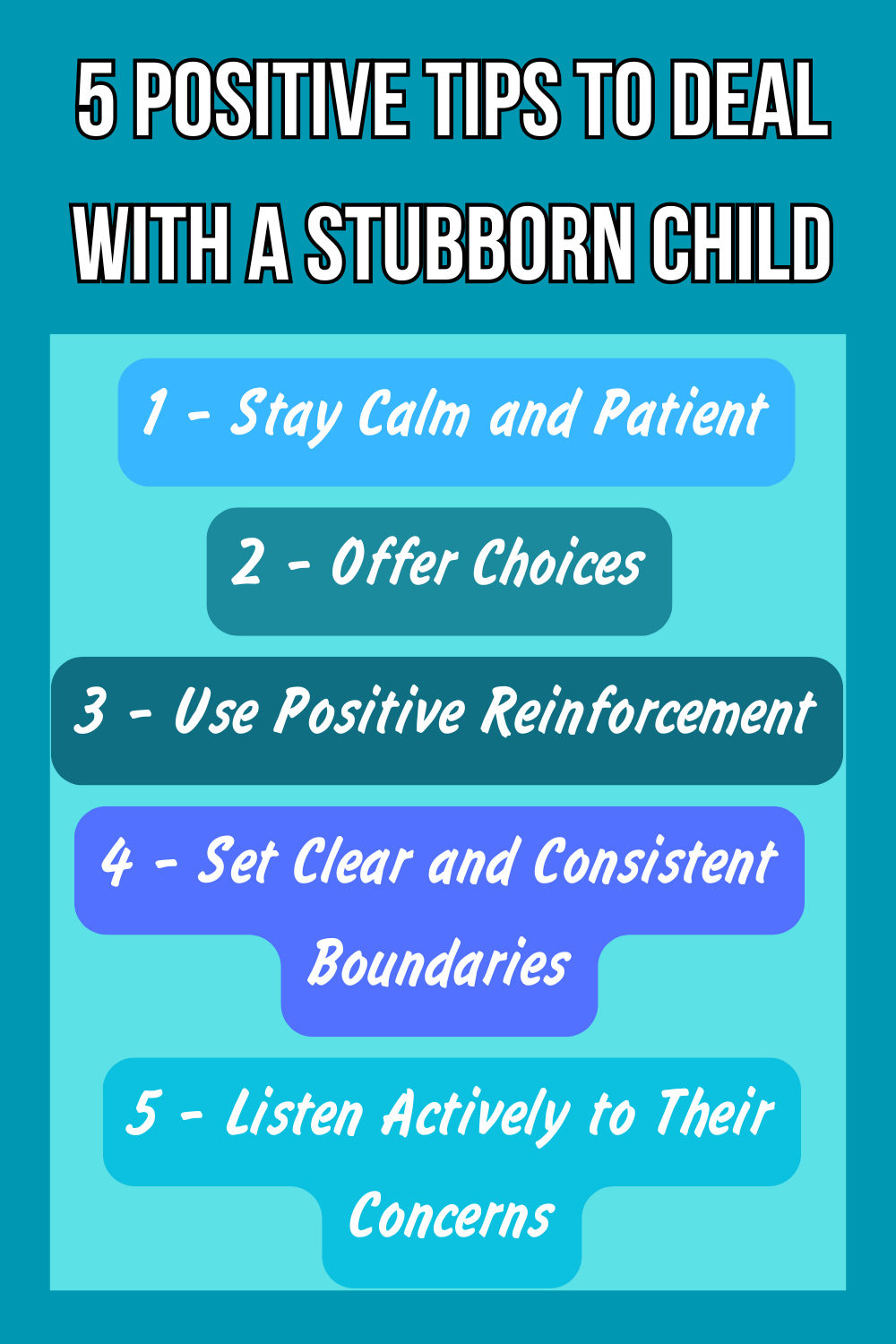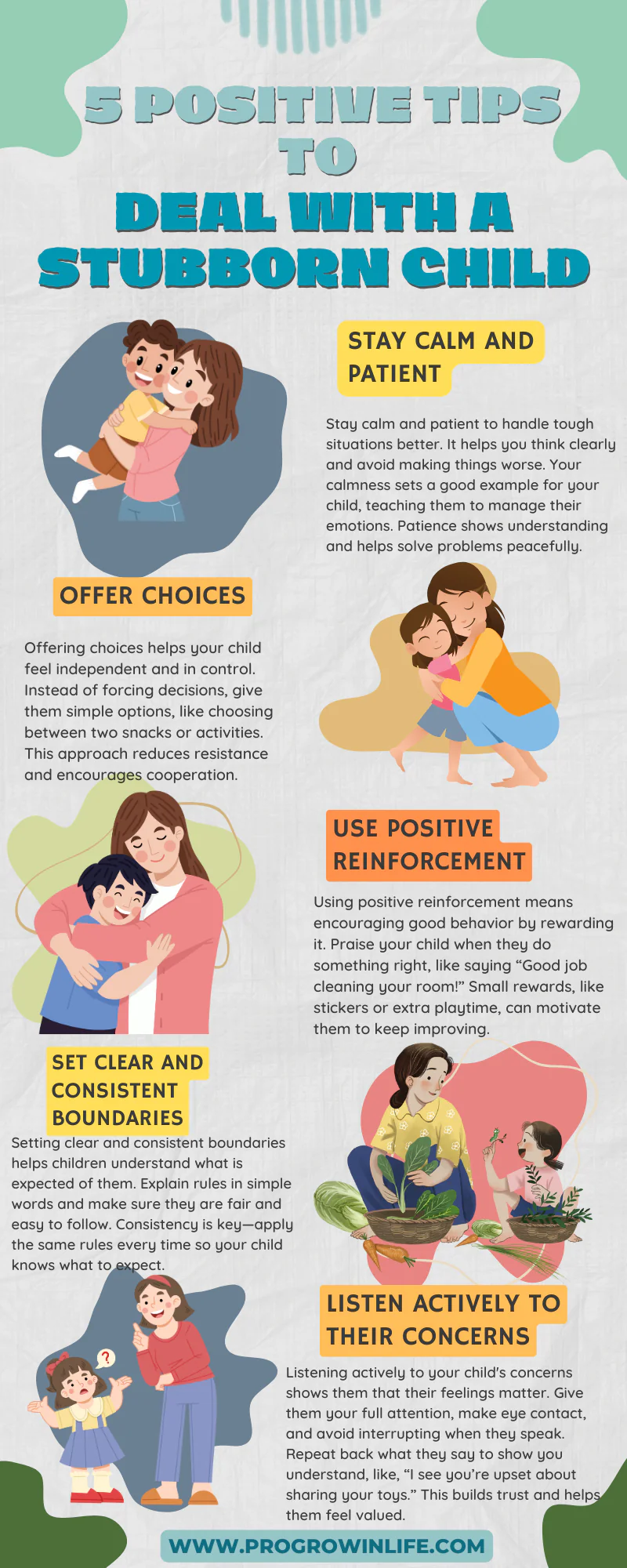Dealing with a stubborn child can be challenging, but it’s important to approach the situation with patience and understanding.
Children often display stubbornness as a way of asserting their independence, expressing frustration, or seeking attention.
As parents or caregivers, it’s essential to use positive and constructive strategies to manage stubborn behavior without escalating conflicts.
By creating an environment of clear boundaries, empathy, and encouragement, you can guide your child toward better behavior while maintaining a strong, trusting relationship.
In this guide, we’ll explore five positive tips to effectively deal with a stubborn child and foster a more cooperative and harmonious connection.
Table of Contents
Stay Calm and Patient
Staying calm and patient is one of the most effective strategies when dealing with a stubborn child.
Children often test boundaries as they navigate their emotions, and how an adult responds can significantly influence the situation.
If a parent or caregiver becomes frustrated or angry, it can escalate the situation, making the child more resistant and less likely to listen.
When you remain calm, you set a positive example for emotional regulation.
Children learn by observing, and when they see an adult responding calmly to difficult situations, they are more likely to adopt similar strategies.
Staying patient also helps to avoid power struggles, which can be counterproductive.
Instead of reacting impulsively, give yourself a moment to collect your thoughts, take a deep breath, and approach the situation with understanding.
Additionally, maintaining a calm demeanor allows for clearer communication.
A stubborn child may be less likely to respond positively if they sense tension or frustration in the adult’s voice.
By staying calm, you create an environment where the child feels safe to express themselves and are more likely to open up to reason.
Patience also enables you to address the root cause of stubborn behavior. Often, a child’s resistance is a response to unmet needs, whether emotional or physical.
By taking the time to listen and assess the situation calmly, you can identify what is driving the behavior and work towards a more constructive solution.
Related Reading:
Be a First-Time Mom: My Sweet Experience with 10 Helpful Tips
Being a Single Mom: Is It Easy or Not? (10 Challenges Uncovered)
Offer Choices
Offering choices is a powerful and positive strategy for dealing with a stubborn child.
When children feel like they have some control over their decisions, it can significantly reduce resistance and encourage cooperation.
Rather than imposing commands, giving children the option to choose between two or more acceptable alternatives helps them feel empowered while still maintaining boundaries.
For example, instead of saying, “You need to eat your vegetables now,” you can offer a choice like, “Would you like to eat your carrots first or your broccoli?”
This simple shift in approach gives the child a sense of autonomy, making them feel involved in the decision-making process.
Offering choices can apply to various situations, such as selecting clothes, choosing activities, or deciding when to complete tasks like homework.
This strategy works because it helps children understand that while they may not have control over everything, they still can make decisions within certain limits.
It fosters a sense of responsibility, as children learn to weigh their options and think critically about their preferences.
However, it’s essential to ensure that the choices are both reasonable and within your control.
For instance, when offering options, make sure both choices are acceptable to you, ensuring that you don’t set yourself up for further conflict. By offering choices, you encourage independence, reduce frustration, and create a more cooperative environment, making it easier to navigate stubbornness and establish a positive parent-child relationship.

Related Reading:
Being a Good Mom Is Better Than Being a Perfect Mom: Top 10 Reasons Why
How to Be a Good Mother: 11 Ways to Support Your Son and Daughter
Use Positive Reinforcement
Using positive reinforcement is an effective way to encourage desirable behavior in a stubborn child.
Positive reinforcement involves acknowledging and rewarding good behavior, which motivates the child to repeat those actions.
Rather than focusing on negative behaviors, emphasizing what the child does right helps create a more supportive and encouraging environment.
For example, when a child listens to instructions or follows through with a task without resistance, acknowledging this behavior with praise can reinforce their actions.
Simple phrases like “Great job listening” or “I love how you did that without complaining” can boost the child’s confidence and make them more likely to cooperate in the future.
Over time, the child will associate positive actions with praise, encouraging them to act in a way that elicits more of the same.
It’s important to be specific with praise, as it helps the child understand exactly what they did well.
For instance, instead of saying “Good job,” you might say, “You did an excellent job putting your toys away without being asked.” This makes the reinforcement more meaningful and helps the child connect their actions to a positive outcome.
Rewards don’t always have to be material. Verbal praise, extra playtime, or even a sticker can serve as effective reinforcements.
By consistently acknowledging positive behavior, you foster a child’s self-esteem and motivate them to continue making good choices, reducing the likelihood of stubbornness in the future. Positive reinforcement creates a cycle of encouragement that builds trust and cooperation.
Related Reading:
Top 10 Characteristics of a Good Mother
Top 10 Roles of a Mother: What Makes Her So Special
Set Clear and Consistent Boundaries
Setting clear and consistent boundaries is essential when dealing with a stubborn child.
Children thrive in environments where they know what to expect and understand the limits placed upon them.
Clear boundaries provide structure, safety, and a sense of security, helping children feel more confident in their actions and decisions.
When rules are consistent and well-communicated, children are less likely to test limits repeatedly, as they know what is expected of them.
To set effective boundaries, it’s important to be specific and age-appropriate.
For example, instead of vague instructions like, “Behave at the table,” a more specific rule could be, “Please keep your hands to yourself while eating.
This provides clarity and makes it easier for the child to understand what is acceptable behavior. The rules should be simple and realistic, taking into account the child’s developmental stage and temperament.
Consistency is key in enforcing boundaries. If rules are enforced inconsistently, children may become confused and resistant, testing limits more often. For instance, if a parent allows a child to stay up late on some nights but insists on an earlier bedtime on others, the child may push back and resist the rule.
Consistency helps reinforce the idea that the rules are non-negotiable, fostering respect and understanding.
Moreover, it’s important to model behavior that aligns with the boundaries set. If a child sees adults adhering to the same rules, they are more likely to follow suit.
By setting and maintaining clear, consistent boundaries, parents can minimize conflict and encourage cooperation.
Related Reading:
13 Top Qualities of a Good Mother: What Makes Her Amazing
Why a Mother Is a Blessing That No One Can Replace
Listen Actively to Their Concerns
Listening actively to a child’s concerns is a crucial step in addressing stubborn behavior and fostering a healthy relationship.
Children may act out or become resistant, especially when they feel misunderstood. By actively listening, you create an environment where the child feels valued, heard, and respected. This can reduce frustration and build trust between you and the child.
Active listening involves hearing what the child says and paying attention to their tone, body language, and emotional cues.
It means being fully present and giving your undivided attention without distractions.
When a child expresses their feelings or frustrations, validating their emotions is important.
For instance, saying something like, “I understand you’re frustrated because you didn’t get to choose the game,” shows empathy and lets the child know their feelings are acknowledged.
Once you’ve listened, it’s essential to respond thoughtfully. This might involve asking questions to clarify their needs or concerns, offering reassurance, or finding solutions together.
When children feel their opinions matter, they are more likely to cooperate and open up in the future. Moreover, active listening can help you identify the root cause of the child’s stubbornness, whether it’s due to unmet emotional needs, a lack of understanding, or an external issue.
By practicing active listening, you encourage a child to express themselves in constructive ways, rather than resorting to resistance. This builds mutual respect and helps reduce stubbornness, fostering a stronger, more understanding parent-child bond.

Bottom Line From Progrowinlife.
To sum up, handling a stubborn child can be challenging, but positive approaches make a big difference.
By staying calm, communicating clearly, setting boundaries, giving choices, and encouraging good behavior, you can guide your child effectively.
Remember, stubbornness often comes from a child’s need for independence, so patience and understanding are key.
These tips will help you build a stronger connection with your child while teaching them to manage their behavior positively and healthily.
